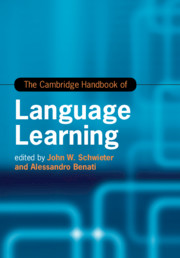Book contents
- The Cambridge Handbook of Language Learning
- Cambridge Handbooks in Language and Linguistics
- The Cambridge Handbook of Language Learning
- Copyright page
- Contents
- Figures
- Tables
- Contributors
- Acknowledgements
- Introduction
- Part I Theories
- Part II Methods
- Part III Skill Development
- Part IV Individual Differences
- Part V Pedagogical Interventions and Approaches
- Part VI Context and Environment
- Part VII Moving Forward
- Index
- References
Part II - Methods
Published online by Cambridge University Press: 25 June 2019
- The Cambridge Handbook of Language Learning
- Cambridge Handbooks in Language and Linguistics
- The Cambridge Handbook of Language Learning
- Copyright page
- Contents
- Figures
- Tables
- Contributors
- Acknowledgements
- Introduction
- Part I Theories
- Part II Methods
- Part III Skill Development
- Part IV Individual Differences
- Part V Pedagogical Interventions and Approaches
- Part VI Context and Environment
- Part VII Moving Forward
- Index
- References
Summary
While earlier research on second language learning may have distinguished language acquisition from language use (Krashen, 1982), more recent conceptualizations of second language learning have come to refer to the field of second language acquisition (SLA) as second language studies (e.g., Gass, Lee, & Roots, 2007) and second language development (e.g., Larsen-Freeman, 2018). In light of this conceptual shift, the focus has also expanded beyond the individual language learner, with the research lens turning towards the language teacher and the wider social ecology in which the learner is embedded. In tandem with the broadening of the field, there has been a marked increase in the volume of qualitative research published since Lazaraton’s (1995) earlier lament over the paucity of qualitative studies published in applied linguistics journals. While the distribution of qualitative research across international journals remains uneven (Benson et al., 2009), with some journals such as Applied Linguistics, The Modern Language Journal, System, and TESOL Quarterly being more open to the publication of qualitative research than others, the field of SLA has also witnessed a proliferation of handbook chapters on qualitative research (e.g., Benson, 2012; De Costa, Valmori, & Choi, 2017; Harklau, 2011; Lew, Yang, & Harklau, 2018) and books (e.g., Holliday, 2007; Mirhosseini, 2017b; Richards, 2003) that focus exclusively on qualitative research.
- Type
- Chapter
- Information
- The Cambridge Handbook of Language Learning , pp. 109 - 230Publisher: Cambridge University PressPrint publication year: 2019

